The ASUS Z370-I Gaming Review: Mini-Me Mega Motherboard
by Joe Shields on May 21, 2018 11:00 AM EST- Posted in
- Motherboards
- Intel
- Mini ITX
- Asus
- Coffee Lake
- Z370
- Z370-I Gaming
Visual Inspection
The ASUS Z370-I Gaming motherboard, like other Mini-ITX boards, doesn't leave a lot of room for design aesthetics. There is really only room for the components we can see on the board, without having to add more real estate vertically like the ASRock X299-E ITX/ac or ROG Impact boards did with extra daughterboards. The ASUS board uses two separate aluminum heatsinks to cool the power delivery area as well as the chipset and front M.2 slot. Outside of that, there is some grey stenciling in what little free area there is on the front. While the two DRAM slots are not reinforced, the single PCIe slot is.
A total of 13 RGB LEDs line the back of the board of the board under the 24-pin ATX plug and SATA ports. This is designed to give the board a warm glow when it is powered on. An additional RGB header is located on the right side of the board next to the 24-pin ATX plug - all can be controlled through the ASUS Aura Lighting software.
The Z370-I comes with a total of three 4-pin fan headers, one of which is designed for AIO Pumps. The CPU fan header is located near the 8-pin EPS 12V connector towards the top left. The AIO pump (no mention of power capabilities) sits in the middle and the chassis fan sits just above the PCIe slot on the bottom. Both CPU headers are hybrid and support 3-pin (DC) or 4-pin (PWM) fans and are able to output 1A/12W.
ASUS uses its Digi+ chip (ASPB1400BT) in a 6 + 2 configuration using the OnSemiconductor 4C09B-RG050 MOSFETs. Sending power to the CPU is a single 8-pin EPS connector.
The right side of the board is where a lof the action happens. From left to right we are able to see a front panel USB 3.0 header, the two DRAM slots, four SATA ports (2 on each side of the DRAM slots), a USB 2.0 header, RGB LED header, and the 24-pin ATX connector.
This picture above shows a close up of SATA ports 1/2 while 3/4 are seen in the background by the single clip DRAM slots.
One of the interesting elements to this mothebroard is the audio section. ASUS likes to spend time on the audio, and here they have managed to do most of what is possible on a full-size ATX board: PCB separation between analog and digital signals, an EMI shield over the codec (Realtek ALC1220A), and additional audio filter caps. Most other motherboards in this segment opt for a simple solution, or with the more built-up Mini-ITX boards we have seen daughter boards offer extra space for audio performance. The key here from ASUS is to make sure that the EMI shield does not interfere with large graphics cards.
The back panel IO (seen below) is fairly busy containing the USB ports, audio outputs, network connections, and video outputs
- 2 x USB 3.0 ports
- 4 x USB 2.0 ports
- Displayport and HDMI Video Outputs
- Intel I219-V NIC
- 2 x USB 3.0 ports
- Intel Wi-Fi stack
- Audio stack
In the Box
ASUS includes the following:
- User Manual
- M.2 2242 Mounting Kit
- I/O Shields
- 4 x SATA cables
- 2 x M.2 screw packages
- 1 x CPU installation tool
- 1 x ROG addressable LED strip (not pictured)
- 1 x ASUS 2T2R Wi-Fi Moving antennas
- 1 x SCD
- 1 x Panel cable
- 1 x Strix Series stickers




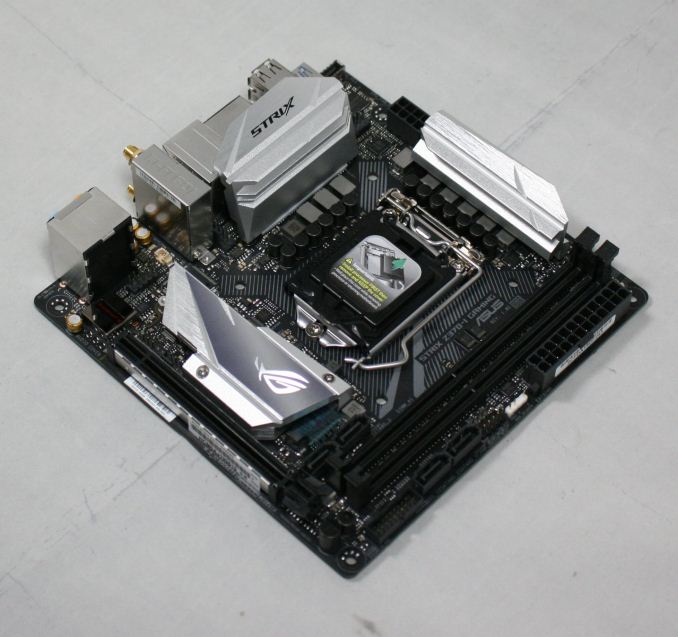
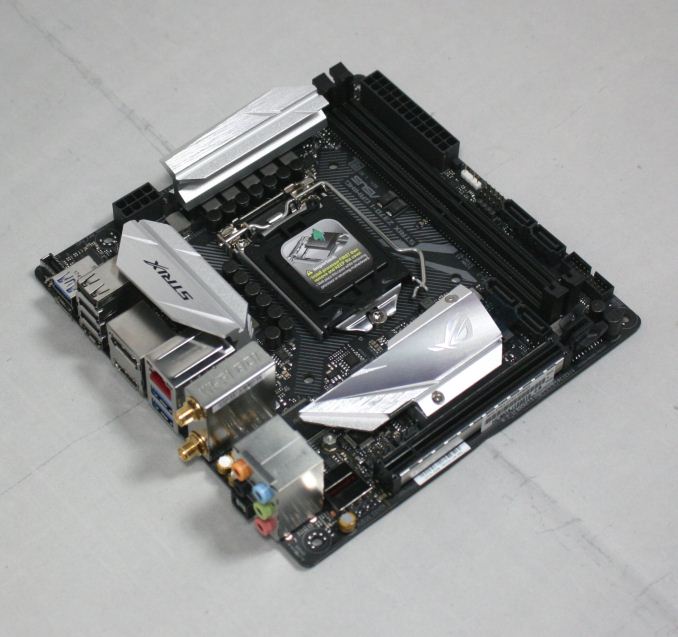
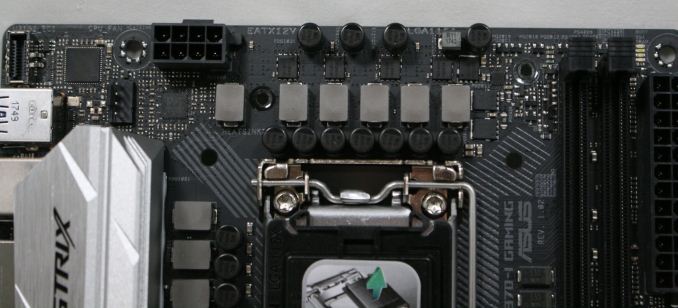
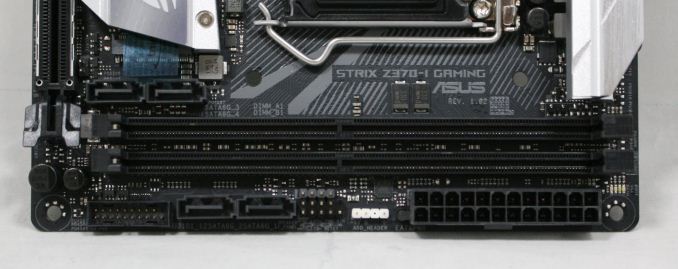
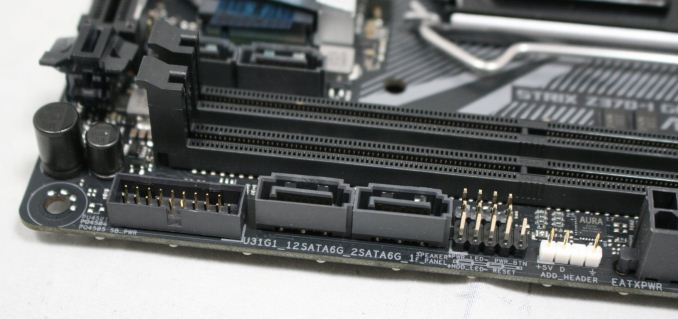
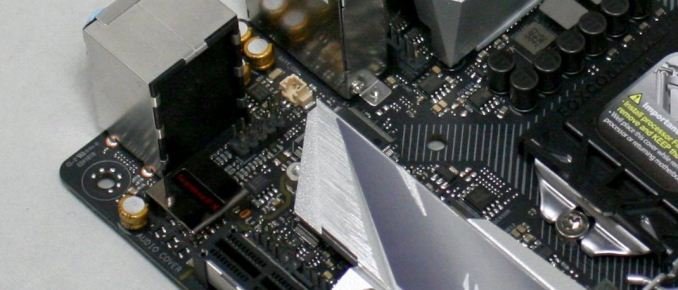
















37 Comments
View All Comments
Chaitanya - Monday, May 21, 2018 - link
Price premium for the compact build just doesnt justify the cooling compromises that mini-ITX brings to the table especially for people living in hot climatic regions of the globe where ambient temps can cross 40Deg C.jordanclock - Monday, May 21, 2018 - link
And...? So this one product might not be suitable for people using tiny air cooled cases in warm places? And who are you to say what is and isn't justified for different people? Liquid cooling pretty much negates the space issues. Also a mini-ITX board does not need to be used in a mini-ITX case.tarqsharq - Monday, May 21, 2018 - link
Yeah, it seems odd to complain about cooling problems when you're already at 104F... might want to invest in AC at that point or just get a massive case with tons of fans, not conducive to ITX at all!MDD1963 - Monday, May 21, 2018 - link
"Also a mini-ITX board does not need to be used in a mini-ITX case."I'm sure there's at least one tard looking to stuff one into Corsairs largest ATX doublewide case right now....
meacupla - Tuesday, May 22, 2018 - link
Do you mean the Obsidian 1000D? Because that case has room for an E-ATX and mITXSamus - Thursday, May 24, 2018 - link
Haha that's exactly what I was thinking. Dual PC's in a PC!Joe Shields - Monday, May 21, 2018 - link
I'm not sure what one has to do with the other. One isn't paying a premium for the cooling, or less of it - that simply comes with the territory of the Mini-ITX board in general.Clearly, if one is living in such an area where your inside temperature is 40C, additional cooling considerations are likely warranted, almost regardless of the build size. I do not understand the root of that comment...
Chaitanya - Monday, May 21, 2018 - link
One of the main selling point of Mini-Itx motherboards is smaller and compact PC builds and thats how both motherboard and case manufacturers have been marketing it. So if you want to take full advantage of smaller system then going the route of smaller Mini-Itx cases is necessary which means a restriction on size of cooler that can be used. And using tower style Itx cases defeats the purpose as one can easily go to micro Atx form factor without increasing the volume of pc case too much.Ratman6161 - Monday, May 21, 2018 - link
I guess we can, or at least should, agree that there isn't a one size fits all and that Mini-ITX in general falls into the "not for everybody" category. Then again, If I built my wife a system in a mammoth full tower case, I'd probably be getting some very dirty looks to...so that is also a "not for everybody" sort of build.All that said, this article is actually a motherboard review. I am personally interested in a Mini-ITX build, but for a more mainstream, non-gaming sort of system. so what I'd like to see is a different article that addresses Mini-ITX in general and the issues, pros and cons surrounding it; selecting components that fit in a reasonable case, coolers that fit etc. One thing I would have liked to have seen in this particular article - even though its a motherboard review - is what it looks like actually mounted in a case and using components one might actually be able to fit in such a case. Notably, the GTX 980 isn't something that you could actually use in a Mini-ITX build so why benchmark with it? Or am I wrong about that?
Ratman6161 - Monday, May 21, 2018 - link
Just looked again. Ditto on the power supply and dual 120MM cooler. If they wouldn't fit in a Mini-ITX case why use them for testing the motherboard intended for such a case?